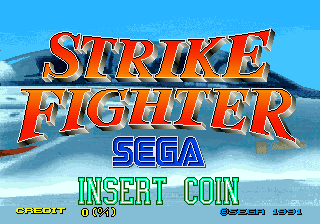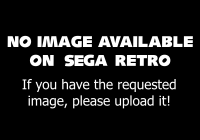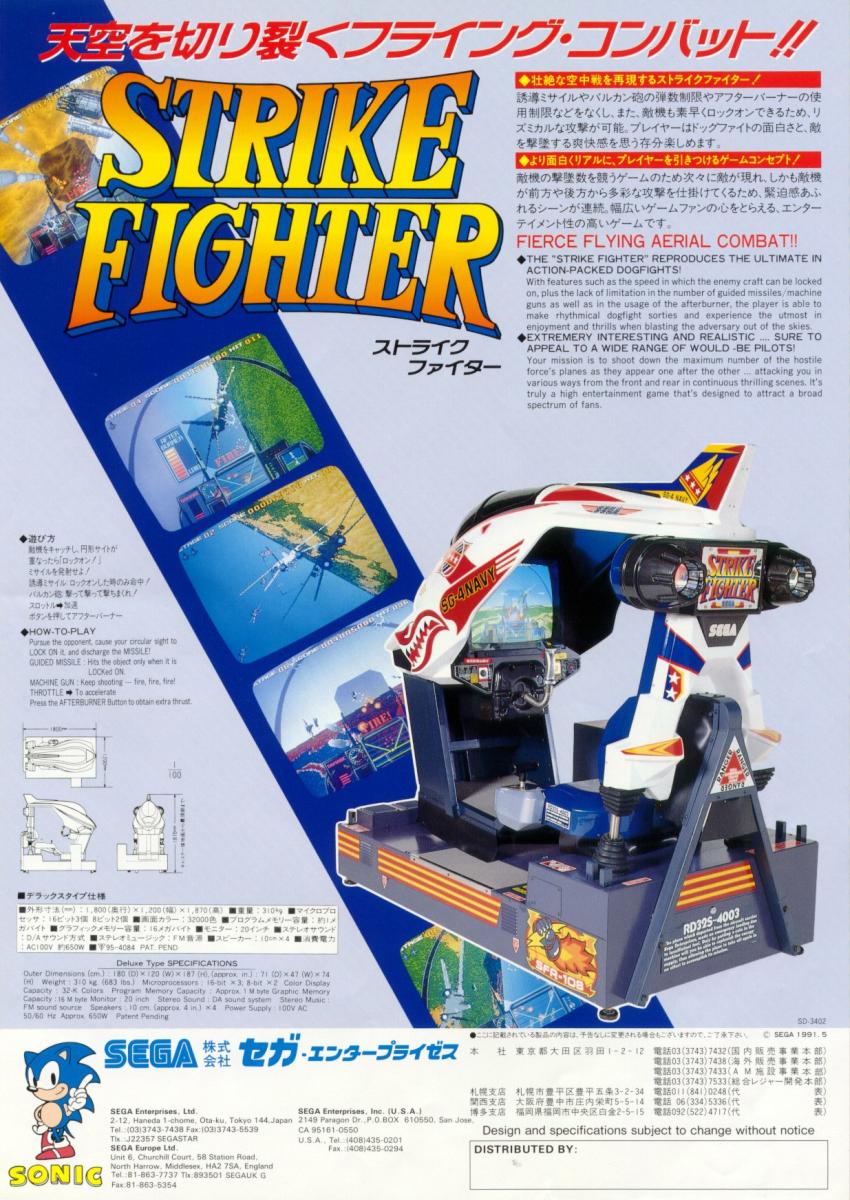Difference between revisions of "Strike Fighter"
From Sega Retro
m (Text replace - "Sega Mega CD" to "Sega Mega-CD") |
Hyperspeed34 (talk | contribs) |
||
| (23 intermediate revisions by 9 users not shown) | |||
| Line 1: | Line 1: | ||
{{Bob | {{Bob | ||
| bobscreen=StrikeFighter title.png | | bobscreen=StrikeFighter title.png | ||
| − | + | | publisher=[[Sega Enterprises, Ltd.]] | |
| − | + | | developer=[[Sega R&D 8]] | |
| − | | publisher=[[Sega]] | ||
| − | | developer=[[Sega | ||
| system=[[Sega Y Board]] | | system=[[Sega Y Board]] | ||
| − | |||
| sounddriver= | | sounddriver= | ||
| peripherals= | | peripherals= | ||
| players=1 | | players=1 | ||
| genre=Shoot-'em-Up | | genre=Shoot-'em-Up | ||
| − | | releases={{ | + | | releases={{releasesArcade |
| − | | | + | | ybd_date_jp=1991-06 |
}} | }} | ||
}} | }} | ||
| − | {{stub}}''''' | + | {{stub}}'''''{{PAGENAME}}''''' (ストライクファイター) is [[Sega Y Board]] arcade combat flying game developed by [[Sega R&D 8]] and manufactured by [[Sega Enterprises, Ltd.]] A spin-off of the popular [[Studio 128]] series ''[[After Burner]]'', the game is a spiritual evolution of the developer's earlier 1990 arcade title ''[[G-LOC: Air Battle]]'', and was released exclusively to Japanese arcades in June 1991. |
| − | + | While Strike Fighter has never seen any home ports in its original form, the game was brought to the [[FM Towns]] in 1992 as ''[[After Burner III]]'', marketed as a mainline ''[[After Burner]]'' game; this port would later arrive on the [[Sega Mega-CD]] courtesy of developer [[CRI]] later that year. | |
| − | ''Strike Fighter'' | + | ==Gameplay== |
| + | ''Strike Fighter'', like ''G-LOC'' primarily takes place from a cockpit view, where the player is tasked with shooting down enemy planes (while making sure not to be shot down themselves). Also like ''G-LOC'', the game pans out to a third-person perspective if an enemy is on your tail. The major difference between the two is that whereas ''G-LOC'' uses a goal-based mission system, ''Strike Fighter''<nowiki>'</nowiki>s levels are similar in design to ''After Burner''<nowiki>'</nowiki>s, simply finishing when the player reaches a certain distance. | ||
| − | == | + | ===Stages=== |
| − | {{ | + | {{InfoTable|imagewidths=200| |
| + | {{InfoRow | ||
| + | | title=Stage 01 | ||
| + | | screenshot=Notavailable.svg | ||
| + | | desc= | ||
| + | }} | ||
| + | {{InfoRow | ||
| + | | title=Stage 02 | ||
| + | | screenshot=Notavailable.svg | ||
| + | | desc= | ||
| + | }} | ||
| + | {{InfoRow | ||
| + | | title=Stage 03 | ||
| + | | screenshot=Notavailable.svg | ||
| + | | desc= | ||
| + | }} | ||
| + | {{InfoRow | ||
| + | | title=Stage 04 | ||
| + | | screenshot=Notavailable.svg | ||
| + | | desc= | ||
| + | }} | ||
| + | {{InfoRow | ||
| + | | title=Stage 05 | ||
| + | | screenshot=Notavailable.svg | ||
| + | | desc= | ||
| + | }} | ||
| + | {{InfoRow | ||
| + | | title=Stage 06 | ||
| + | | screenshot=Notavailable.svg | ||
| + | | desc= | ||
| + | }} | ||
| + | {{InfoRow | ||
| + | | title=Stage 07 | ||
| + | | screenshot=Notavailable.svg | ||
| + | | desc= | ||
| + | }} | ||
| + | {{InfoRow | ||
| + | | title=Stage 08 | ||
| + | | screenshot=Notavailable.svg | ||
| + | | desc= | ||
| + | }} | ||
| + | {{InfoRow | ||
| + | | title=Stage 09 | ||
| + | | screenshot=Notavailable.svg | ||
| + | | desc= | ||
| + | }} | ||
| + | {{InfoRow | ||
| + | | title=Stage 10 | ||
| + | | screenshot=Notavailable.svg | ||
| + | | desc= | ||
| + | }} | ||
| + | {{InfoRow | ||
| + | | title=Stage 11 | ||
| + | | screenshot=Notavailable.svg | ||
| + | | desc= | ||
| + | }} | ||
| + | {{InfoRow | ||
| + | | title=Stage 12 | ||
| + | | screenshot=Notavailable.svg | ||
| + | | desc= | ||
| + | }} | ||
| + | {{InfoRow | ||
| + | | title=Stage 13 | ||
| + | | screenshot=Notavailable.svg | ||
| + | | desc= | ||
| + | }} | ||
| + | {{InfoRow | ||
| + | | title=Stage 14 | ||
| + | | screenshot=Notavailable.svg | ||
| + | | desc= | ||
| + | }} | ||
| + | {{InfoRow | ||
| + | | title=Stage 15 | ||
| + | | screenshot=Notavailable.svg | ||
| + | | desc= | ||
| + | }} | ||
| + | }} | ||
| + | |||
| + | ==Versions== | ||
| + | ''Strike Fighter'' saw most of its content re-branded as ''[[After Burner III]]'' for the [[FM Towns]] and [[Sega Mega-CD]]. The main difference between the two from a gameplay perspective is that ''After Burner III'' always gives users the option of playing from a third-person perspective. ''Strike Fighter'' on its own has not been ported to any home consoles. | ||
| + | |||
| + | ==Production credits== | ||
| + | {{mainArticle|{{PAGENAME}}/Production credits}} | ||
| + | |||
| + | ==Promotional material== | ||
| + | {{gallery | ||
| + | |{{gitem|StrikeFighter YBoard JP Flyer.jpg|JP flyer}} | ||
| + | }} | ||
| + | |||
| + | ==Physical scans== | ||
| + | {{ScanArcade | ||
| + | | type=upright | ||
| console=Y Board | | console=Y Board | ||
| region=JP | | region=JP | ||
| − | |||
}} | }} | ||
| − | {{ | + | ==References== |
| + | <references/> | ||
| + | |||
| + | {{StrikeFighterOmni}} | ||
{{AfterBurner}} | {{AfterBurner}} | ||
| − | |||
| − | |||
Latest revision as of 21:15, 8 November 2024
| Strike Fighter | |||||||||
|---|---|---|---|---|---|---|---|---|---|
| System(s): Sega Y Board | |||||||||
| Publisher: Sega Enterprises, Ltd. | |||||||||
| Developer: Sega R&D 8 | |||||||||
| Genre: Shoot-'em-Up | |||||||||
| Number of players: 1 | |||||||||
|
This short article is in need of work. You can help Sega Retro by adding to it.
Strike Fighter (ストライクファイター) is Sega Y Board arcade combat flying game developed by Sega R&D 8 and manufactured by Sega Enterprises, Ltd. A spin-off of the popular Studio 128 series After Burner, the game is a spiritual evolution of the developer's earlier 1990 arcade title G-LOC: Air Battle, and was released exclusively to Japanese arcades in June 1991.
While Strike Fighter has never seen any home ports in its original form, the game was brought to the FM Towns in 1992 as After Burner III, marketed as a mainline After Burner game; this port would later arrive on the Sega Mega-CD courtesy of developer CRI later that year.
Contents
Gameplay
Strike Fighter, like G-LOC primarily takes place from a cockpit view, where the player is tasked with shooting down enemy planes (while making sure not to be shot down themselves). Also like G-LOC, the game pans out to a third-person perspective if an enemy is on your tail. The major difference between the two is that whereas G-LOC uses a goal-based mission system, Strike Fighter's levels are similar in design to After Burner's, simply finishing when the player reaches a certain distance.
Stages
| Stage 01 | |
|---|---|
| Stage 02 | |
| Stage 03 | |
| Stage 04 | |
| Stage 05 | |
| Stage 06 | |
| Stage 07 | |
| Stage 08 | |
| Stage 09 | |
| Stage 10 | |
| Stage 11 | |
| Stage 12 | |
| Stage 13 | |
| Stage 14 | |
| Stage 15 | |
Versions
Strike Fighter saw most of its content re-branded as After Burner III for the FM Towns and Sega Mega-CD. The main difference between the two from a gameplay perspective is that After Burner III always gives users the option of playing from a third-person perspective. Strike Fighter on its own has not been ported to any home consoles.
Production credits
- Main article: Strike Fighter/Production credits.
Promotional material
Physical scans
| Y Board, JP | ||||
|---|---|---|---|---|
References
| Strike Fighter | |
|---|---|
|
Main page | Comparisons | Credits | Magazine articles | Reception
| |




